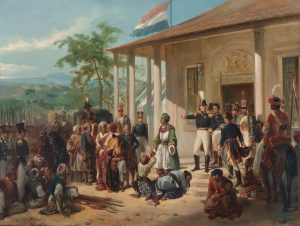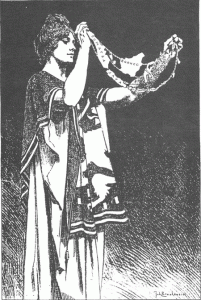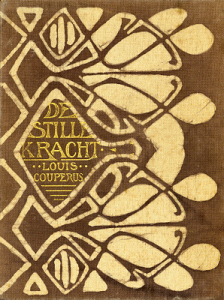
The evil of colonialism is not expressed in a sum of its benefits and downsides. These debates over British railways in India and economic development miss the point of colonialism entirely. Colonialism is violence. It is not just that it entails violence as an inevitable product of its system, colonialism itself is an act of epistemic violence. Colonies require colonial subjects, which needs a cleavage to separate the humans from the lesser creatures.
In my Dutch primary school our teacher would illustrate history class with the school’s antique school prints. They piqued my interest in East Asia, but in hindsight they were rather orientalist. Invariably, you would see a pittoresque landscape, a mise-en-scène of stern Dutch overlooking interchangeable inlanders going about their daily business, or unwavering Dutch ships of the Dutch East Indies Company (VOC). For a little bookish boy longing for a more exciting world these heroic tales of ‘discovery’ were enthralling.
Our classes put less emphasis on the unfortunate collateral damage of these exciting adventures. The prints perpetuated the unaddressed colonial gaze, as the teacher left out the fundamentals of the story: the dependency of colonialism on violence. First, metal violence, in the mind of the colonist. After that, physical. Then, after armed resistance has been eliminated and the people’s bodies are subjugated, the work of mental domination begins. The tools: dichotomies. A community is taken and carved up into slices. Those slices are carved up again: superior versus inferior, salvageable versus beyond civilisation, useful versus useless, rational versus irrational, etc.
The Anglo-Dutch way of colonisation was based on this process. It used indirect government and divide-and-rule. When the first Europeans arrived in Southeast Asia, they found a thriving trading system, in which indigenous, Arab, Chinese, and Persian merchants sailed back and forth between the myriad harbour cities. When the Dutch arrived at Strait Sunda, initially they were dependent on the ruler of Jayakarta, who allowed them to set up a trading post in the city’s Chinatown in 1611. In 1619, having gained enough strength, the Dutch burned down the city and massacred its population. In its place they founded their colonial capital: Batavia, now known as Jakarta. This is how the ‘pearl’ in the Dutch crown began.
What followed were centuries of complex alliance formation with different rulers and ethnic groups to expand Dutch influence. The Dutch East India Company imposed its monopoly on more and more port cities, ending the region’s open trade by forcing everyone to go through Batavia. Keeping different groups apart was vital to the European minority ruling vast territories. As Wang Gungwu said, ‘a virtue was made of having each racial and ethnic group preserve its own way of life.’ In order to achieve that, distinctions needed to be introduced and enforced. Benedict Anderson recounts how the VOC forced recognition of the difference between Javanese and Chinese, which seemed to have been of less consequence to the locals before. Until the advent of modern nationalism made it redundant, Dutch colonial policy strictly guarded ethnic distinctions by way of mandatory dress codes and separate legal classes. Europeans or those involved in crimes affecting Europeans through the legal doctrine of connexiteit were tried before European courts. Chinese were taken care of by Chineesche Raad (Kong Koan/公館). Initially they fell under European criminal law, while family matters were settled within the community, until that too fell under Dutch civil law by the turn of the century. Indonesians fell under the adatrecht, a Dutch Romantic reconstruction of the supposed traditional laws and customs of a primordial Indonesia before Islam. Europeans were on top. Japanese and Thai the best-treated of all Asians. Ranking somewhat below them, a local-born Chinese would get a passport saying he was a ‘Dutch subject – alien oriental,’ that is, alien to both the Netherlands and Indonesia. A Javanese would be an ‘inlander,’ native to the land and ruled by their prince.

This policy also meant that no single group could grow so powerful that it could threaten Dutch dominance. Occasionally, this lead to fear and paranoia. Then the cleavages could lead to terrible physical violence. In the first century of its existence, as Leonard Blussé has argued, Batavia was basically a Chinese town: they dominated the trade and developed the agriculture around the city. The Dutch merely oversaw and collected taxes. This all changed when tensions came to head in 1740, when the Chinezenmoord (Chinese Murder/Geger Pacinan/红溪惨案) took place: the urban Chinese community was slaughtered in its entirety by the Dutch, with help from indigenous troops, after an uprising on the surrounding countryside. More than 10,000 people were killed. However, the Chinese would later still return to their prominent middle role, often serving as much hated tax farmers, or middle class merchants. When during the second half of the 19th century more Dutch started to move to the colonies, the more progressive would often turn in righteous anger against the ‘exploitative’ Chinese and take on a protective paternalistic role towards the inlanders, an attitude comparable to that of the middle class in Eastern and Central Europe towards the Jews after the modernising state no longer needed them in their traditional function of middle men between ruler and ruled, highlighted by Daniel Chirot and Anthony Reid.

In the case of Indonesia, clues of colonial epistemic violence provided by Dutch literature are plentiful. Of the nicknames for Insulinde, the most telling is de Gordel van Smaragd, or ‘the Girdle of Emerald.’ It is meant as an admiration of the astonishing beauty of the archipelago. But the metaphor is a perfect example of how the colony is viewed: they are precious stones that need to be cut and polished, so they can become worthy of display. At the same time stones are inert and their nature impossible to change beyond the cutting of the surface. The finder can own the stones and keep them as a symbol of their splendour. It is in this light that one should interpret the display of a meticulously documented colony in the collections of the Tropenmuseum in Amsterdam and the archives of Leiden University.
This passive object can also be found in the voluminous ‘Indische letteren,’ the Dutch Indies lettres. My favourite work is De Stille Kracht (The Silent Force) by Louis Couperus from 1900. It is no coincidence that the triumph of naturalism in Dutch literature concerns Indonesia. A Dutch family of colonial administrators is slowly worn down by the ‘mystical’ force of the country, which appears to form an organic whole that turns against the foreign elements. Couperus, at least, is insightful enough to make it so that this ‘silent force’ only seems silent because the Dutch do not understand that it is in fact the opposition of the Indonesians to their presence. But a more general survey of the literature shows patterns that quickly make it difficult to continue reading these books. Complex white main characters, a few decorative native or mixed-race characters on the edge of the story. Overwhelming nature, scheming people. This is perhaps what is required for colonialism to work: pushing the colonial object into the background, so they can be regarded as forces of nature that can be manipulated. The colony as a whole, including its people, becomes a stage on which the lives of colonials play out.

This deficit in Dutch literature, often written by former colonials or descendants of colonials, becomes especially apparent after contrasting the works with This Earth of Mankind, written by Southeast Asia’s onetime hope for a Nobel Prize for Literature, Pramoedya Ananta Toer. In a way, his work is the inverse of the Dutch writers’: there is a planters family, but the inlandse wife chases away her useless Dutch husband and the plantation has never done better. For once we get to see behind the façade of the ‘shady’ Chinese baba who runs a whorehouse. We travel to native kampongs not as outsiders gazed at with distrust, but as a homecoming.
As Susie Protschky writes in her analysis of three works of the Indies literature, as post-Raffles the Dutch colony’s racial structure became strictly hierarchised: ‘native lineage came to be associated with moral shadiness.’ In many books of the Dutch Indies lettres you can find this idea: the untrustworthy, licentious natives often literally living in dirty, confined dark, shady places, contrasted with the down-to-earth Dutch in their clean, airy villas painted a bright white. Eurasians straddled the divide, thereby calling its naturalness into question. The characters in these novels are obsessed with maintaining the colonial distinctions. In any work, characters spend a lot of time talking about heritage, origin, and pedigree. Subjects in Couperus’ work go crazy because in the tropical weather nothing stays clean; everything is ‘corrupted’ by the climate.
A lot of these attitudes still resonate in modern-day views of Asia. Singapore’s obsession with cleanliness and purity—contrasting itself with neighbouring Malaysia and Indonesia—provides a stark contrast with the colonial imagery of dirty, shady Chinese. The distinction between expat and migrant is an especially clear example of that: the expat meticulously guards their distinction from the locals, because it is on this distinction that the superiority of their transitory stay rests. The global Asian city is often presented as a glitzy superstructure in daylight on top of the nightworld of a gritty underbelly, even though most Asians live neither in shiny office towers nor in Kowloon Walled Cities. Another example is Hollywood’s representation of the Asian business man as a janus-faced person, going back and forth between official and less official worlds. This too has roots in the colonial world. Not only were non-white traders often presented as shifty, the colonised also had to divide their attention between the official public world of the colonial ruler, and the private sphere, locations of subjugated knowledges so important for the formation of anti-colonial nationalism as Partha Chatterjee pointed out. Colonists did not understand this private sphere, which made them feel both threatened and disgusted by a lack of understanding, so they stigmatised it.
Many non-Westerners note their amusement at the Westerner’s proclivity to categorise everything. But that characteristic perhaps is what made them so suitable for the epistemic violence required for colonial rule. Just as in the world of the books, building a colony is essentially about maintaining boundaries.
Leave a Reply